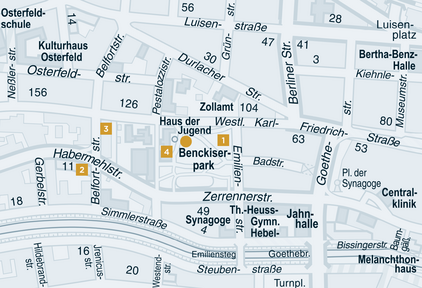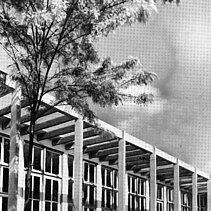Benckiserpark Before 1945
Places and Buildings Before 1945
[1] 1905
A popular river bathing place for Pforzheims citizens was at the "Hammergumpen". The bathing place was created by ponding the "Mühlbach" at the "Benckiserwehr". The name "Hammergumpen" indicates the usage of water power for operating the hammer mill of Brothers Benckiser.
[2] around 1900
The iron works of Brothers Benckiser resulted in 1755 from a melting furnace and a hammer mill of the margrave. In the 19th century, this works became the biggest industrial enterprise of the town. Above all, this enterprise was famous inland and abroad for constructing iron bridges. Moreover, the company produced installations for gas- and drinking water supply.
[3] around 1900
The extensive company ground of the ironworks Brothers Benckiser extended from "Emilienstraße" in the East up to "Benckiserstraße" in the West. The last facility expansion was around 1897 when a factory hall was built. The face of it was richly structured with risalite, pediment superstructure and ornamental fair faced brickwork. The room impression of the three-nave hall is characterized by a riveted iron structure with circumferential galleries.
[4] around 1900
Before 1790, the family Benckiser let build an elegant villa in classical style on the eastside of the company ground. In the middle of the house there was a spacious banquet hall with side rooms. To the South and to the North of the main building two-story pavilions were connected with living space. The property included a private park, todays "Benckiserpark".
Benckiserpark After 1945
Places and Buildings After 1945
[1] 2016
The Benckiserpark resulted from the private garden of late baroque of the villa Benckiser. In 1918, the family Benckiser gave their garden to the town under condition that it would be maintained as public park. For todays site the petite "Benckiserbrunnen" was casted in 1875 as single piece in the ironworks next door. It reminds of the "Grösseltal"-water pipeline that was built at that time which supplies the town up to now reliably with drinking water.
[2] 2016
In the years 1923 to 1924 the jewel factory "Kordes & Lichtenfels" was established according to plans of architects Karl Faller and Josef Clev from Pforzheim. Wall pillars arrange rhythmically the mainly glazed front which follows the slight bend of "Habermehlstraße". After liquidation of this jewel factory, which existed since 1884, the building was rebuilt for subsequent commercial use.
[3] 2016
The former work hall of the ironworks Brothers Benckiser was built in 1897. After considerable war damage, the reconstruction followed in 1949 in simplified and shortened way for the enterprise Pitzmann & Pfeiffer. Since 1980, this hall is used as industry-wide training center for the building craft.
[4] 1951
On the foundation walls of the war-damaged Villa Benckiser, the „Haus der Jugend“ was created with US-american support in 1949 and was extended several times later on. On the parkside the building opens to a terrace. Fritz Theilmann from Kieselbronn created a ceramic mural over the main entrance on the westside with the title "Begegnung" (=encounter). This popular youth hangout was extended several times and presents itself from 2017 on with an additional first floor.











